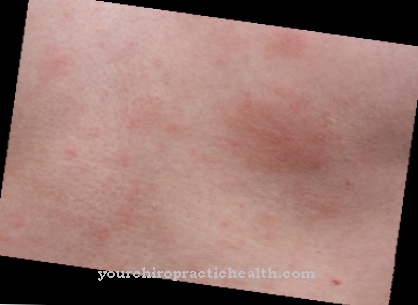There are many different types of one in medicine Poor eyesight. Some are innate, others are acquired. In any case, poor eyesight should be corrected in order to prevent further damage to the eye and to ensure a better quality of life for those affected.
What is poor eyesight?

A visual impairment is present when an eyeball is not or no longer able to depict an object correctly on the retina and the person affected cannot perceive objects or can no longer perceive objects in the same way as someone with healthy eyesight.
Classic visual impairments are those in which those affected can no longer see objects clearly. A distinction is made between hyperopia, generally also known as farsightedness, and myopia, also popularly called nearsightedness. In addition, there are also poor eyesight in which those affected cannot differentiate between the colors red and green, the so-called color vision disorders, or can see poorly at night, the so-called night blindness or hemeralopia.
Another possible visual impairment is double vision, also known as diplopia in technical jargon, in which those affected cannot see properly three-dimensionally due to an incorrect eye position. In some cases, amblyopia also occurs when there is poor vision, although the eye is organically completely healthy.
causes
Poor eyesight can have different causes. Most visual impairments are congenital. In order to be able to see clearly, the eye has to bundle light rays in such a way that the focal point is exactly on the retina. The lens of the eye is therefore flexible so that it can focus the light rays as necessary to be able to see a targeted object clearly.
If an eyeball is too long or too short or the lens of the eye is too curved, the focus shifts. In addition, age is often to be mentioned as the cause of poor eyesight. With age, the flexibility of the eye lens decreases and objects at certain distances can then only be perceived blurred, this is also referred to as presbyopia.
However, some visual impairments are also acquired and often arise from the subconscious endeavor to correct a genetic misalignment of the eyes or to suppress the transmission of the image of a defective eye to the brain. Night blindness, on the other hand, can be hereditary and acquired in other ways.
You can find your medication here
➔ Medicines for visual disturbances and eye complaintsDiseases with this symptom
- Farsightedness
- Squint
- myopia
- Red Green weakness
- Color blindness
- Night blindness
Diagnosis & course

In contrast to presbyopia, most visual impairments develop in childhood. That is why children are now examined early for possible visual impairments in order to correct them and prevent further damage.
A doctor (e.g. an ophthalmologist) or an optician can diagnose whether there is nearsightedness and farsightedness and how severe it is with the help of a refractive index. The poor eyesight is then corrected with a visual aid in the form of glasses or contact lenses. Color blindness or night blindness is tested using different methods.
If poor eyesight is not recognized in childhood, they often show up in old age. If the flexibility of the lens of the eye decreases, those affected can no longer correct an existing nearsightedness or farsightedness themselves and then notice weak eyesight by themselves.
In addition, poor eyesight is often associated with headache or eye pain. Correction with a visual aid is also possible without any problems as people get older. Nevertheless, it is better to recognize poor eyesight early on, as poor eyesight can progress to some extent and, in the worst case, an untreated visual impairment can result in a misalignment of the eyes and thus further visual impairment. In the case of farsighted people in particular, there is a risk that an adjustment of the eye lens to the refractive power can lead to inward squint.
Amblyopia may develop after double vision. In myopic people, there is also the risk of the retina peeling off, which can lead to complete blindness of the eye. However, if a change in the retina is noticed early, it can be corrected surgically without any problems.
Complications
As a rule, poor eyesight cannot be treated, which means that the symptoms can be eliminated in just a few circumstances. This includes, above all, laser eye lasers. If poor eyesight occurs over time and is not treated, it will not improve, but in most cases will get worse.
Those who do not use glasses or contact lenses despite their poor eyesight are unnecessarily straining the muscles of the eyes. This usually makes the poor eyesight even worse. If visual impairment occurs, the patient must immediately apply for a visual aid and use it. When using contact lenses, dry eyes are a common side effect.
The rule here is: if possible, avoid contact lenses and rather wear glasses. Contact lenses should be removed beforehand, especially when sleeping. There are only a very few cases of complications when laser eyes are used. Most operations are successful and remove the poor eyesight. Those who do not wear visual aids despite their poor eyesight often see unclear or blurred. This not infrequently leads to headaches or migraines and disorders of balance.
When should you go to the doctor?
Direct treatment by a doctor is not absolutely necessary for poor eyesight, but it is very advisable. As a rule, the patient's eyesight deteriorates if the patient has an untreated visual impairment. Young people in particular should therefore always consult an ophthalmologist or optician if they have this symptom. The ophthalmologist should be consulted if symptoms other than poor eyesight occur. These include, for example, pain in the eye or blurred vision. These symptoms may be an illness of the eye that needs to be investigated.
If the patient is only suffering from the poor eyesight, an optician can be visited to prescribe suitable glasses or contact lenses. Poor eyesight is a common symptom, especially in old age.
Even without symptoms, children should regularly visit an ophthalmologist for check-ups. This means that any visual defects or visual impairments that may be present can be detected early and treated directly. This avoids consequential damage. As a rule, a specialist can be consulted directly; a visit to the general practitioner is not necessary.
Doctors & therapists in your area
Treatment & Therapy
Myopia and farsightedness can be corrected with glasses or contact lenses. In addition, it is now also possible to surgically restore vision. Often the refractive power of the eyes is changed by using a laser.
The success of an operation depends on the severity and type of poor eyesight and is not always successful. To prevent amblyopia from developing from a diplopia or other poor eyesight, the healthy eye is usually masked over a longer period of time. This ensures that the vision of one eye is not suppressed until a visual impairment develops here.
Color blindness cannot yet be treated, but there are tinted contact lenses or spectacle glasses with which those affected can see much more clearly, at least in daylight. Depending on the underlying causes of night blindness, this is treated differently. Night blindness caused by vitamin A deficiency can be remedied by administering vitamins. Night blindness with other causes is often not treatable and cannot be corrected even with a visual aid.
Outlook & forecast
The outlook for poor eyesight is very difficult to predict and depends heavily on the cause of the poor eyesight. If a visual impairment is not treated or if the eyes are not supported by a visual aid, the visual impairment usually increases and does not go away on its own.
If glasses are not used, the muscles of the eyes have to work harder to see clearly. The strength of the muscles decreases over time and the poor eyesight increases. A visual aid should therefore always be used to compensate for poor eyesight.
Poor eyesight can also occur for a short time, for example with a migraine. In this case, the poor eyesight will go away on its own once the migraine has subsided.
It is possible to correct the poor eyesight with the help of a laser. However, the patient must already be an adult so that the eyesight does not change in the course of life. With this treatment there are usually no complications or other complaints. In old age, poor eyesight is more likely to occur, and it is a common symptom that cannot usually be avoided.
You can find your medication here
➔ Medicines for visual disturbances and eye complaintsprevention
Night blindness resulting from a lack of vitamin A can be prevented with a healthy diet with sufficient vitamin A. However, since most visual impairments have genetic causes, they cannot be countered by certain prophylactic measures. If, however, visual impairments such as farsightedness, nearsightedness or double-sightedness are recognized early and corrected immediately, further visual impairments that can develop from this can be averted.
It is therefore advisable to have the eyes examined at an early stage, especially in children, in order to identify any visual impairments and to correct them with visual aids. It is controversial whether external, unfavorable influences such as reading in poor light can lead to poor eyesight. In order to prevent this risk, however, poor image quality should not be projected onto the retina and, for example, only read when there is sufficient light and the eyes should be given time to relax after a particular effort.
You can do that yourself
It is usually not possible to treat poor eyesight at home. In many cases, medical treatment is also not possible, so that the patient has to live with the poor eyesight for the rest of his life.
Eating a healthy diet can help with night blindness. In this case, the body primarily needs vitamin A and must be supplied with it. A healthy lifestyle with the consumption of fruit and vegetables is ideal for this. As a rule, unnecessary eye strain should be avoided. This also includes long-term work on a monitor or reading content in poor light.
A visual aid should also always be worn with poor eyesight. These can either be glasses or contact lenses. If the visual aid is not worn, the muscles in the eye must work hard to see clearly. This can increase poor eyesight. It is therefore advisable to always wear the visual aid when it is necessary. Regular visits to the ophthalmologist and optician are also recommended. The earlier the visual impairment is recognized, the better it can be treated. An ophthalmologist can also provide information about possible surgical interventions.













.jpg)

.jpg)
.jpg)











.jpg)